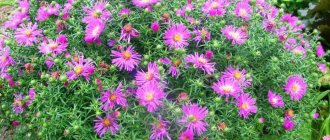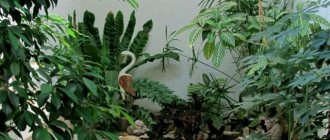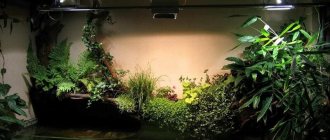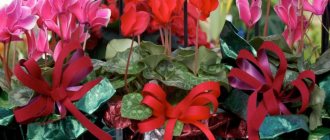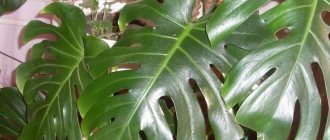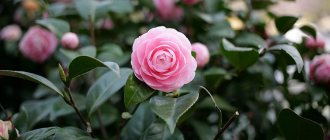The main problem with any windows, even southern ones, is the lack of lighting. Most indoor plants come from the subtropics and tropics, where the intensity of sunlight is significantly higher than even on the southernmost, tallest and cleanest windows in the middle zone.
- Features of growing plants on southern windows
- Features of growing plants on northern windows
- Features of growing plants on eastern and western windows
West side of the house
It can be a good place for planting clematis, actinidia, hydrangea, red rowan, peony and phlox.
Clematis
A luxurious liana will decorate any garden. Clematis does not need particularly bright lighting, but it is necessary to protect them from strong winds and metal structures.
Actinidia
A wonderful exotic plant with unusually decorative leaves. Very beautiful flowering and edible fruits have made actinidia desirable for many gardeners.
Hydrangea
Hydrangea has long been popular among summer residents due to the splendor of its white and pink inflorescences. Some varieties are unpretentious to light and heat and are excellent for planting on the western side.
Red rowan
Red rowan is a classic tree or shrub, without which it is impossible to imagine the Russian style in the landscape. You can even grow rowan from berries. It grows on any soil.
Peony
These perennials do not require special care, but every year they delight gardeners with lush flowering. The western side of the house will be brightened by their spherical flowers and delicate buds of different shades.
Phloxes
These modest but cute flowers grow without problems in the middle zone. Phloxes do not need bright lighting, so they are often planted by summer residents in shaded areas. Plants are demanding on watering and soil fertility.
North side of the house
Here you can plant horizontal juniper, thuja, blue spruce, microbiota, virgin grapes, honeysuckle, and astilbe.
Juniper
Horizontal juniper came to us from North America. It grows well on hillsides and sandy shores of ponds. It is a creeping shrub up to a meter high, with unusually curved branches. It is frost-resistant, does not require special care and will give the northern corner of your garden a special decorative effect.
Thuja
Thuja is a beautiful, cold-resistant plant with original cup-shaped leaves. In addition, it is not particularly sensitive to smoke and can be planted next to a recreation area. Low-maintenance shrubs are used to decorate alleys and hedges.
Blue spruce
Blue spruce trees have long been loved by summer residents for their ease of care and impressive appearance. It is better to purchase mature plants for the site; they take root much faster. The color of the seedlings is sometimes too green, but after a while the spruce will become really blue - the pollen on the needles is responsible for the color.
Microbiota
A unique relict plant – cross-paired microbiota. Over the course of several decades, it has become a favorite of gardeners. The shrub grows very slowly in height, it has horizontal branches and a crown with noticeably distinct tiers. The microbiota is unpretentious in care and loves shady corners.
Maiden grapes
One of the largest and fastest growing perennial vines is the virgin grape. In a short time it is able to drape even a completely smooth-looking wall of a building. The leaves are spaced evenly and receive their share of sunlight, so the crop is quite suitable for the northern side of the garden. At the end of the season, the foliage turns spectacular orange and reddish tones.
Honeysuckle
Honeysuckle is not particularly demanding of heat. When it is still 0 degrees Celsius outside, it begins to awaken, and in mid-May it blooms. The crop bears tasty and extremely healthy berries; they are used for juices, jams and pies fillings.
Astilbe
This spreading bush with curved branches will enhance the northern side of your site with its appearance. Astilbe is not too demanding on lighting. The foliage of this crop is openwork, dark green, burgundy and bronze shades. The color of the plant's inflorescences is quite varied; varieties with white, pink and purple flowers are popular.
How much light should plants have?
The first is obvious. There must be light. Without it, plants will not be able to develop, grow, bloom, or bear fruit.
We all know that the sun looks through the windows differently, and the level of illumination in the room depends not only on whether it is morning outside, day or night. What is also important is what is in front of the window. Are there nearby houses, trees, or a balcony that block the sun? Even the cleanliness of the glass is important!
Second, important. To determine a plant's need for light, it is sometimes useful to know how it is measured. Here we will talk about illumination. Illumination is a physical quantity numerically equal to the luminous flux incident on a unit surface. The unit of illumination is the lux (1 lux (lx) = 1 lumen per square meter). Lumen (lm) is a unit of measurement of luminous flux. For example, a 40 W incandescent lamp produces a luminous flux of 415–460 lm. While a fluorescent lamp of the same power has a luminous flux of 2480 lm. The luminous flux of the sun will be equal to 3.8 x 1028 lm.
Illumination is directly proportional to the luminous intensity of the light source. That is, the more powerful the light source, the higher the illumination.
As it moves away from the illuminated surface, its illumination decreases in inverse proportion to the square of the distance. In other words, the further the light source is from the illuminated object, the less illumination of this object. So, a plant standing 3 m from a window receives 9 times less light than one standing on the windowsill.
We draw conclusions - most of the light enters the room through the window and it is most advantageous to place plants near the window
.
A lux meter was developed to measure light levels. Once you become its lucky owner, you can play to your heart's content, determining which windows in your apartment are more suitable for cacti, and which are suitable only for ferns.
If you don't have a lux meter. On a clear sunny day outside, the maximum illumination is about 100,000 lux, and the average value ranges between 30,000 and 50,000 lux; in heavy clouds it drops to 5,000 lux. In the room, these indicators are, of course, different. Sunlight does not fall directly on the plants; some of it is blocked by window glass, and possibly also by a tree growing in front of the window or lowered curtains. In summer, the illumination directly next to the window ranges from 3,000 to 5,000 lux. In the center of the room it is much smaller: at a distance of 2-3 meters from the window its value is only 500 lux. In winter, not only the daylight hours decrease, but also the light intensity: near the window it is only 500 lux, while in the center of the room it is completely dark.
Typically, plants require light in the range of 500 to 3000 lux for normal functioning. Those plants that are willing to grow and bloom at 500 lux are called shade-tolerant. Plants that require maximum lighting are usually called sun-loving.
Based on the plants’ need for light (very often mention of the necessary lighting can be found in descriptions of plants in encyclopedias), let’s try to place them on our windows.
North windows
For some reason, it is believed that owners of northern windows are unlucky. Like, nothing will grow there, you can close the shop. In fact, this is not so. The lighting on the northern windows is soft, even, without the scorching midday sun. Daily temperature changes are significant. And many plants like this so much. The northern windows have one - in my opinion, the main - plus: the plant will never get sunburn here.
Plants for the north window:
Aglaonema, Adiantum, Aspidistra, Asparagus, Aukuba, angular begonia, gelxin, bordered dracaena, fragrant dracaena, zygocactus, stone, Kalanchoe, Crossbone (not variegated), Japanese legodium, Marante, pepeperomy, Current, peperomiya is series A nightshade , ferns, ivies, passionflower, sansevieria, scindapsus, spathiphyllum, selaginella, tolmia, fatshidera, fatsia, ficus dwarf, climbing philodendron, fittonia, cissus rhombifolia, cineraria, cyclamens.
South windows
Growing plants on a southern window is more troublesome than on a northern one: few plants will tolerate prolonged exposure to direct sunlight and too significant daily temperature changes. Often, during the hottest time of the day, you will have to create shading in the form of a gauze or tulle curtain. Therefore, you need to especially carefully select plants for the windowsill of a south window. Only the most resistant plants that need sun can be placed on the windowsill itself, for example, cacti and other succulents, hoya fleshy, stephanotis profusely flowering, passionflower, etc. If you read in the recommendations for caring for a plant that it loves light, but needs shading, then place it on a table near a south window under the protection of a tulle curtain. Such a place is ideal for decorative foliage flowers such as cyperus, chamerops, cissus, coleus and evergreen myrtle.
Plants for the south window:
Aloe arborescens, Aloe Hanburiana, bouvardia, jasmine Sambac, camellia japonica, Coleus Blume, mammillaria, prickly pear, sedum, Livistona sinensis, plectranthus, fuchsia, haworthia, hoya, cereus, echinocactus, hibiscus, oleander, aglaonema variable, hemanthus white-flowered, dieffenba hiya variegated , Dracaena derema, Dracaena Godsefa, variegated croton, coffee tree, Crassula pursula, Vici pandanus, pink strobilanthes, cacti and succulents, most palm trees, roses, laurel, Kalanchoe, pineapple.
East windows
East windows are ideal in every way. The soft rays of the morning sun are replaced by bright diffused light in the afternoon. The natural, uniform decrease in temperature in the evening allows you to grow all indoor plants here without exception.
They will feel better than others here
asparagus, aucuba, tree begonia, hairy begonia, metallic begonia, emerald begonia, griselinia, dracaena angustifolia, dracaena derema, butcher's broom, myrtle, ivies, cissus, pittosporum, fatsia japonica, ficus, Roussel's epiphyllum, obtuse epiphyllum, Albizia lofanta, emerald begonia , Japanese euonymus, coastal griselinia, ligustrum ovalis, myoporum punctata, pachysandra apex, pittosporum, Pseudopanax Lesson, Indian raphiopepis, Uzambara violet, chlorophytum and many others.
